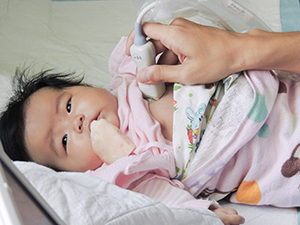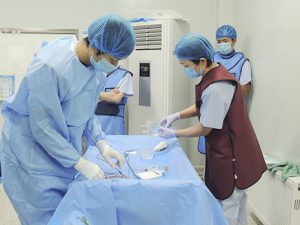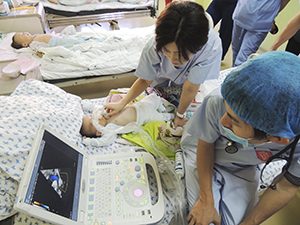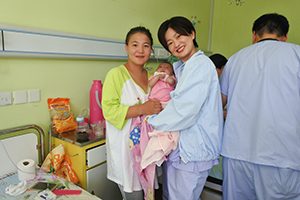Catheter Treatment Team in Mongolia August 2019
1/28/2020
Dr. Naomi Nakagawa gave us herimpression of joining cathter treatment team at National Health Canter for Maternal and Child of Mongolia in August 2019.
My First Visit in Summer
Hiroshima City Hiroshima Citizens Hospital
Department of Pediatric Cardiology
MD. Naomi Nakagawa
Although it was forth times for me to visit Mongolia, visiting in summer was the first time. When I went outside of Chinggis Khan Airport building, I felt fresh air and it was completely different from smoky one of winter and was relieved to escape from the hot summer Japan.
I participated in Catheter Treatment Team this time as usual. Checking the schedule table, which was full of treatment, I was thinking how to much device inventory and treatment content trying to achieve as many treatments as we can.
It was in November 2017 that I participated in last time and in that time, it happened that the inventory of the catheter devices and the delivery sheaths (a long tube to put the device into the heart) did not much in case of closure of atrial septal defect. We must choose a device that is sized to fit the size of the hole. And the thickness of the sheath that fits the size of the device. That is, each device requires a sheath of a size suitable for it. As a result, treatment could not be performed without a sheath that much the device.
Compared to that time, I felt there was room because the inventory of both the device and the sheath was considerably increase this time. Previously, some used sheaths were rounded to a diameter of about 25cm and re-sterilized, and some did not maintain their original shape.
Originally, it is designed for precise control to place the device, but it was transformed completely, so it was happened that was very difficult to control to place.
Fortunately, I did not have to use these things and my stress was reduced.
On the other hand, it is also the true that more severely patients (difficult cases with large defect hole) need to be treated more quickly. So, it is understandable the reason to list this time.
Another thing I was concerned about is that it should be considerable what to do with patients who are estimated to be unable to use device treatment from the view of transthoracic echocardiography (echocardiography observed from outside the body). In Japan, these patients opt for thoracotomy surgery. However, in an environment where it is not easy to decide on a thoracotomy surgery for various reason, it is understandable that at least transesophageal echocardiography should be performed and confirmed. As other opinion, it was obvious that these patients could not be treated with the device, so it might be better that we could give that time and power to those who could be treated.
However, looking back on my experience, by repeating the experience of comparing the findings of transthoracic and the findings of *transesophageal echocardiography, I can judge that device treatment is impossible with transthoracic echo alone, so it may be necessary experience to some extent.
* transesophageal echocardiography: echocardiography under anesthesia and observation from the patient’s mouth into the esophagus through a large test tube
As for transesophageal echocardiography, Mongolian doctors performed transesophageal echocardiography very positively compared to before, and I strongly felt their attitude to learn the technique. Accurate transesophageal echocardiographic evaluation is essential for device closure of atrial septal defect. I stated working on transesophageal echocardiography when device closure of atrial septal defects began in Japan. With that in mind, I was delighted that the efforts of the Mongolian doctors were very good change and good progress.
Compared with the past, there are quite a lot of devices at the hospital, but still, this time, when treating pulmonary valve stenosis, there was not a good balloon to expand the pulmonary valve, we were worried what to do. Many people looked for something that could be substituted. And at last, Tuya who is the secretariat found one balloon in the stock. It was a special balloon called BIB, which had a double structure with another balloon inside the outer balloon.
Normally, this balloon is not used alone to treat pulmonary stenosis, but it was the only one that could fit in size, so we decided to use it. It was my first time to using BIB. The person who should decide the position of the balloon, the person who should expand the inner balloon and the person who should expand the outer balloon, we decided the respective roles and simulated them firmly and executed them. We usually want to communicate as much as possible with Mongolian doctors, so conversations between doctors is in English. But this time, unless the three acts accurately, it will not succeed, Dr. Takanari Fujii (Showa University Hospital), Dr. Kumiyo Matsuo (Osaka Women’s and Children’s Hospital) and I communicated well in Japanese and we successfully deployed the balloon in almost the best position and timing, and achieved good result.
In Japan, it is rare to perform catheter treatment together while belonging to another facilities, so here in Mongolia you can interact with doctors in many facilities and learn each technique. So, I think we have a good opportunity for doctors who are traveling from Japan to study a lot.
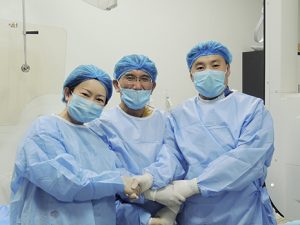
Dr.Nakagawa ( lef), Dr. Takashi Higaki (Ehime University Hospital, center) and Dr. Batundral (right)
It was a short time of three days, but we all spent most of that time, experiencing, learning, and, above all, contributing to the treatment of patients. I hope this exchange will continue, and that catheter treatment in Mongolia will continue to develop, and I would like to cooperate even a little. Thank you to everyone involved for having a good experience.
P.S. During this activity in Mongolia, a former sumo wrestler, Yokozuna Harumafuji, came to cheer us up. I met him for the first time, and it was so impressed that I got goosebumps. He shook hands firmly with his big hands and I received his big power. Thank him from my heart.

